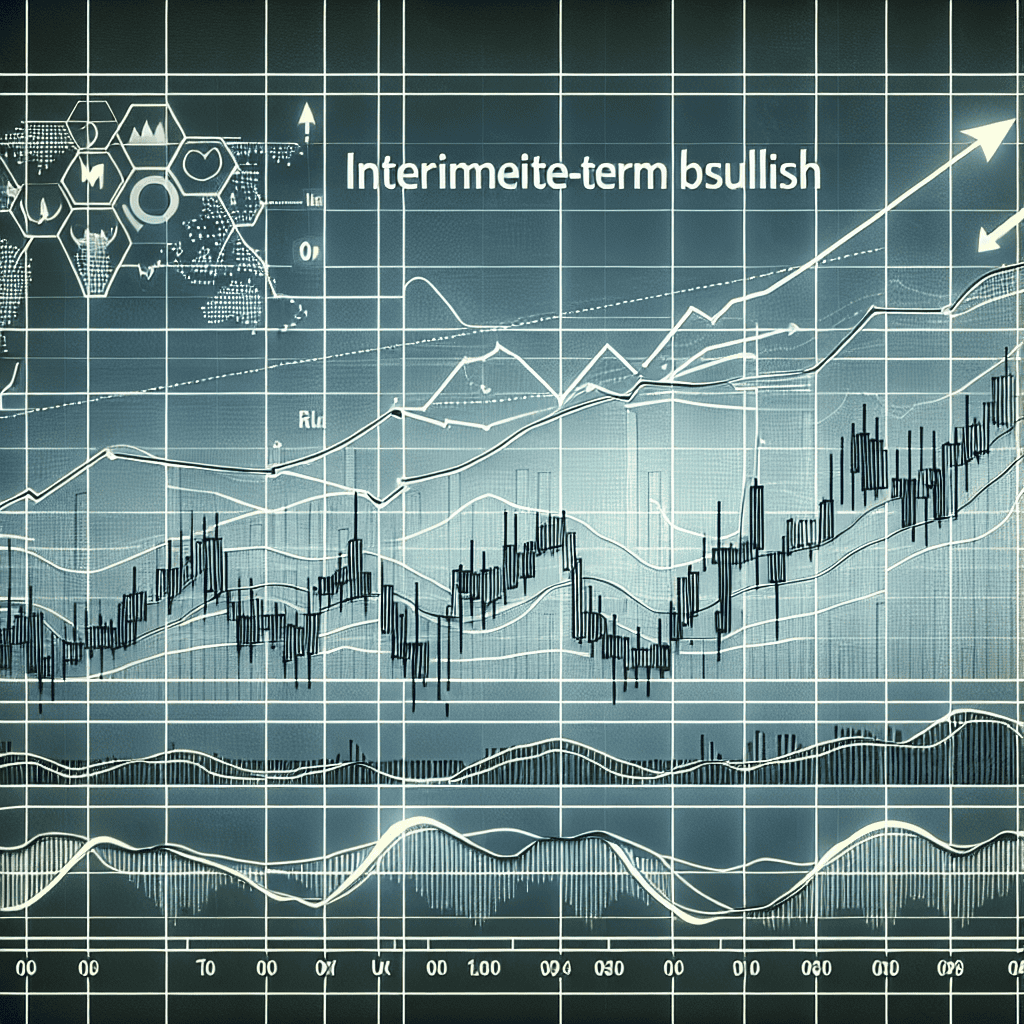“Riding the Wave: Navigating the Intermediate-Term Bullish Horizon with Technical Precision”
Introduction
Intermediate-term bullish outlook in technical analysis refers to a positive expectation for asset prices over a medium time frame, typically ranging from a few weeks to several months. This perspective is grounded in the study of price patterns, trends, and market indicators that suggest upward momentum. Analysts often examine chart patterns such as ascending triangles, moving averages, and support levels to identify potential bullish signals. Additionally, volume analysis and momentum indicators like the Relative Strength Index (RSI) and Moving Average Convergence Divergence (MACD) are employed to confirm the strength of the trend. A comprehensive understanding of these technical elements allows traders and investors to make informed decisions, capitalizing on anticipated price increases while managing risk effectively.
Understanding Intermediate-Term Bullish Patterns in Technical Analysis
In the realm of financial markets, technical analysis serves as a crucial tool for traders and investors seeking to understand price movements and forecast future trends. Among the various timeframes considered in technical analysis, the intermediate-term outlook often garners significant attention due to its balance between short-term volatility and long-term trends. An intermediate-term bullish outlook, in particular, can provide valuable insights into potential upward movements in asset prices, offering opportunities for strategic investment decisions.
To begin with, understanding intermediate-term bullish patterns requires a comprehensive grasp of chart patterns and technical indicators. Chart patterns, such as ascending triangles, cup and handle formations, and inverse head and shoulders, are pivotal in identifying potential bullish trends. These patterns often signal a continuation or reversal of a trend, providing traders with a visual representation of market sentiment. For instance, an ascending triangle pattern, characterized by a horizontal resistance line and an upward-sloping support line, typically indicates a bullish continuation, suggesting that buyers are gaining strength and are likely to push prices higher.
In addition to chart patterns, technical indicators play a vital role in confirming intermediate-term bullish trends. Moving averages, particularly the 50-day and 200-day moving averages, are widely used to assess the overall direction of an asset’s price. When the 50-day moving average crosses above the 200-day moving average, it forms a “golden cross,” a bullish signal that suggests upward momentum. Furthermore, the Relative Strength Index (RSI), a momentum oscillator, can help identify overbought or oversold conditions. An RSI reading above 70 may indicate that an asset is overbought, while a reading below 30 suggests it is oversold. In the context of an intermediate-term bullish outlook, an RSI that emerges from oversold territory and moves towards the mid-range can signal a potential upward trend.
Moreover, volume analysis is an essential component of technical analysis, providing insights into the strength of a bullish trend. An increase in trading volume during price advances often confirms the validity of a bullish pattern, as it indicates strong buying interest. Conversely, declining volume during price increases may suggest a lack of conviction among buyers, potentially signaling a weakening trend. Therefore, analyzing volume alongside price movements can enhance the reliability of intermediate-term bullish forecasts.
While technical analysis offers valuable tools for identifying bullish patterns, it is important to consider external factors that may influence market dynamics. Economic indicators, geopolitical events, and changes in monetary policy can all impact asset prices, sometimes overriding technical signals. Consequently, integrating fundamental analysis with technical insights can provide a more comprehensive view of the market, allowing for more informed investment decisions.
In conclusion, an intermediate-term bullish outlook in technical analysis involves a careful examination of chart patterns, technical indicators, and volume analysis. By identifying and confirming bullish trends, traders and investors can capitalize on potential upward movements in asset prices. However, it is crucial to remain vigilant and consider external factors that may affect market conditions. By combining technical and fundamental analysis, market participants can enhance their ability to navigate the complexities of financial markets and make strategic investment choices. As always, maintaining a disciplined approach and continuously updating one’s analysis in response to evolving market conditions is essential for success in the ever-changing landscape of financial markets.
Key Indicators Signaling a Bullish Outlook
In the realm of financial markets, technical analysis serves as a crucial tool for investors seeking to understand potential future price movements. As we delve into the intermediate-term bullish outlook, several key indicators emerge, signaling a promising trajectory for market participants. These indicators, when analyzed collectively, provide a comprehensive view of the market’s current state and its potential direction.
To begin with, moving averages are fundamental in technical analysis, offering insights into the market’s momentum. The 50-day and 200-day moving averages are particularly significant. When the 50-day moving average crosses above the 200-day moving average, it forms what is known as a “golden cross.” This pattern is widely regarded as a bullish signal, suggesting that upward momentum is gaining strength. Currently, several major indices and stocks are exhibiting this pattern, reinforcing the bullish sentiment among investors.
In addition to moving averages, the Relative Strength Index (RSI) is another pivotal indicator. The RSI measures the speed and change of price movements, oscillating between zero and 100. An RSI above 70 typically indicates that an asset is overbought, while an RSI below 30 suggests it is oversold. In the context of a bullish outlook, an RSI that hovers around 50 and is trending upwards can indicate that there is still room for growth before reaching overbought conditions. This scenario is currently observed in various sectors, further supporting the intermediate-term bullish perspective.
Moreover, the analysis of volume trends provides valuable insights into the strength of a market move. An increase in trading volume accompanying a price rise often signifies strong investor confidence and a robust bullish trend. Conversely, a price increase on declining volume may indicate a lack of conviction, potentially signaling a reversal. Presently, many stocks and indices are experiencing rising prices with corresponding increases in volume, suggesting that the current upward trend is backed by solid investor participation.
Furthermore, the examination of chart patterns can offer additional confirmation of a bullish outlook. Patterns such as ascending triangles, cup and handle formations, and bullish flags are indicative of potential upward breakouts. These patterns reflect periods of consolidation followed by a continuation of the prevailing trend. The presence of these formations in the current market landscape suggests that the bullish momentum is likely to persist in the intermediate term.
Additionally, the analysis of market breadth provides a broader perspective on the overall health of the market. Market breadth indicators, such as the advance-decline line, measure the number of advancing stocks versus declining ones. A rising advance-decline line indicates that more stocks are participating in the upward movement, which is a positive sign for the sustainability of the bullish trend. Recent data shows a favorable advance-decline ratio, further bolstering the bullish outlook.
In conclusion, the convergence of these technical indicators paints a compelling picture of an intermediate-term bullish outlook. The alignment of moving averages, favorable RSI levels, robust volume trends, supportive chart patterns, and positive market breadth collectively suggest that the market is poised for continued growth. While no single indicator can predict market movements with absolute certainty, the synthesis of these signals provides a strong foundation for investors to anticipate a bullish trajectory in the coming months. As always, it is essential for investors to remain vigilant and consider a comprehensive approach, integrating both technical and fundamental analyses to make informed decisions.
Analyzing Moving Averages for Bullish Trends
In the realm of technical analysis, moving averages serve as a fundamental tool for investors and traders seeking to identify potential bullish trends in the market. These averages, which smooth out price data by creating a constantly updated average price, are instrumental in discerning the underlying direction of an asset’s price movement. By analyzing moving averages, one can gain insights into the intermediate-term bullish outlook of a particular security or market index.
To begin with, it is essential to understand the different types of moving averages commonly used in technical analysis. The simple moving average (SMA) and the exponential moving average (EMA) are the most prevalent. The SMA calculates the average price over a specific number of periods, providing a straightforward view of the price trend. In contrast, the EMA gives more weight to recent prices, making it more responsive to new information. Both types of moving averages have their merits, and the choice between them often depends on the trader’s preference and the specific market conditions.
When analyzing moving averages for bullish trends, one of the key indicators to observe is the crossover. A bullish crossover occurs when a shorter-term moving average crosses above a longer-term moving average. This event is often interpreted as a signal that the asset’s price is gaining upward momentum, suggesting a potential bullish trend. For instance, a common strategy involves the 50-day SMA crossing above the 200-day SMA, known as the “golden cross.” This pattern is widely regarded as a strong bullish signal, indicating that the asset may experience sustained upward movement.
In addition to crossovers, the slope of the moving average itself can provide valuable insights into the market’s direction. An upward-sloping moving average suggests that prices are generally increasing, reinforcing the bullish outlook. Conversely, a downward-sloping moving average may indicate a bearish trend. Therefore, monitoring the angle and direction of the moving average can help traders confirm the strength and sustainability of a bullish trend.
Moreover, moving averages can also serve as dynamic support and resistance levels. In a bullish trend, the price of an asset often finds support at its moving average, bouncing off it as it continues to rise. This behavior underscores the moving average’s role as a psychological level where buying interest may emerge. Observing how the price interacts with its moving average can provide further confirmation of a bullish trend’s validity.
While moving averages are powerful tools, it is crucial to consider them in conjunction with other technical indicators and market factors. Relying solely on moving averages may lead to false signals, as they are lagging indicators that reflect past price action. Therefore, combining moving averages with other analytical tools, such as relative strength index (RSI) or volume analysis, can enhance the accuracy of trend identification and increase confidence in a bullish outlook.
In conclusion, moving averages are indispensable in technical analysis for identifying intermediate-term bullish trends. By examining crossovers, slopes, and interactions with price levels, traders can gain valuable insights into the market’s direction. However, it is essential to use moving averages in conjunction with other indicators to confirm signals and mitigate the risk of false interpretations. Through careful analysis and a comprehensive approach, investors can effectively leverage moving averages to navigate the complexities of the financial markets and capitalize on potential bullish opportunities.
The Role of Volume in Confirming Bullish Sentiment

In the realm of technical analysis, volume plays a pivotal role in confirming bullish sentiment, serving as a crucial indicator that can validate or refute price movements. As investors and traders seek to decipher the market’s direction, understanding the interplay between price and volume becomes essential. Volume, representing the number of shares or contracts traded in a given period, provides insights into the strength and sustainability of a price trend. When analyzing an intermediate-term bullish outlook, volume can offer valuable confirmation that the upward movement is supported by genuine market interest.
To begin with, a price increase accompanied by rising volume is often seen as a strong bullish signal. This scenario suggests that more participants are entering the market, driven by optimism and confidence in the asset’s potential. The increased trading activity indicates that the upward price movement is not merely a result of speculative trading but is backed by substantial buying interest. Consequently, this alignment between price and volume can reinforce the belief that the bullish trend is likely to continue.
Moreover, volume can also help identify potential reversals or continuations of a trend. For instance, if a stock experiences a price pullback but the volume remains low, it may indicate that the selling pressure is weak and that the bullish trend could resume. Conversely, if a price decline is accompanied by high volume, it might signal a more significant shift in market sentiment, suggesting that the bullish outlook could be in jeopardy. Thus, volume analysis can provide early warnings or confirmations of changes in market dynamics.
In addition to these scenarios, volume can also be used to assess the validity of breakout patterns. When a stock breaks through a resistance level with high volume, it is generally considered a more reliable signal of a bullish breakout. The increased volume suggests that the breakout is supported by strong buying interest, increasing the likelihood of a sustained upward movement. On the other hand, a breakout on low volume may be viewed with skepticism, as it could indicate a lack of conviction among market participants.
Furthermore, volume analysis can be enhanced by using various technical indicators, such as the On-Balance Volume (OBV) or the Volume Price Trend (VPT) indicator. These tools help traders and analysts quantify the relationship between volume and price changes, providing additional layers of insight into market sentiment. For example, a rising OBV line in conjunction with an upward price trend can reinforce the bullish outlook, as it suggests that volume is supporting the price increase.
In conclusion, volume serves as a vital component in confirming bullish sentiment within technical analysis. By examining the relationship between price movements and trading activity, investors can gain a deeper understanding of market dynamics and make more informed decisions. Whether assessing the strength of a trend, identifying potential reversals, or validating breakout patterns, volume provides essential clues about the underlying forces driving the market. As such, incorporating volume analysis into an intermediate-term bullish outlook can enhance the accuracy and reliability of technical assessments, ultimately aiding investors in navigating the complexities of financial markets.
Identifying Bullish Reversal Patterns
In the realm of technical analysis, identifying bullish reversal patterns is a crucial skill for traders and investors aiming to capitalize on potential upward market movements. These patterns, which signal a shift from a downtrend to an uptrend, can provide valuable insights into market sentiment and future price action. Understanding and recognizing these patterns can significantly enhance one’s ability to make informed trading decisions.
One of the most widely recognized bullish reversal patterns is the “double bottom.” This pattern typically forms after a sustained downtrend and is characterized by two distinct troughs at approximately the same price level, separated by a peak. The double bottom suggests that the asset has found a strong support level, and the subsequent breakout above the peak indicates a potential reversal. Traders often look for increased volume during the breakout as confirmation of the pattern’s validity, as this suggests heightened buying interest.
Another important pattern to consider is the “inverse head and shoulders.” This pattern is similar to the double bottom but consists of three troughs: a lower low flanked by two higher lows. The neckline, drawn across the peaks between these troughs, serves as a critical resistance level. A breakout above the neckline, accompanied by increased volume, signals a bullish reversal. The inverse head and shoulders pattern is particularly significant because it often precedes substantial price advances, making it a favorite among technical analysts.
In addition to these classic patterns, candlestick formations also play a vital role in identifying bullish reversals. The “hammer” candlestick, for instance, is a single-candle pattern that appears at the bottom of a downtrend. It features a small body with a long lower shadow, indicating that sellers pushed the price down significantly during the session, but buyers managed to drive it back up by the close. This price action suggests a potential reversal, especially when confirmed by subsequent bullish candles.
Similarly, the “morning star” is a three-candle pattern that signals a bullish reversal. It begins with a long bearish candle, followed by a small-bodied candle that gaps down, and concludes with a long bullish candle that closes well into the body of the first candle. This pattern indicates a shift in momentum from sellers to buyers and is often seen as a strong reversal signal.
While these patterns provide valuable insights, it is essential to consider them within the broader context of market conditions. Factors such as overall market trends, economic indicators, and geopolitical events can influence the effectiveness of these patterns. Therefore, combining technical analysis with fundamental analysis can offer a more comprehensive view of potential market movements.
Moreover, risk management remains a critical component of any trading strategy. Even the most reliable patterns can fail, leading to unexpected losses. Setting stop-loss orders and determining appropriate position sizes can help mitigate risks and protect capital.
In conclusion, identifying bullish reversal patterns is a fundamental aspect of technical analysis that can offer significant advantages to traders and investors. By recognizing patterns such as the double bottom, inverse head and shoulders, and key candlestick formations, market participants can better anticipate potential trend reversals. However, it is crucial to consider these patterns within the broader market context and employ sound risk management practices to enhance the likelihood of success. As with any analytical approach, continuous learning and adaptation are essential to navigating the ever-evolving financial markets.
Using Fibonacci Retracements to Predict Bullish Movements
In the realm of technical analysis, Fibonacci retracements serve as a pivotal tool for traders and analysts aiming to predict potential bullish movements in the market. This method, rooted in the mathematical principles discovered by Leonardo Fibonacci, involves identifying potential reversal levels by measuring the prior price movement. By applying Fibonacci retracement levels to a price chart, traders can identify key support and resistance levels, which are crucial for making informed trading decisions.
To begin with, Fibonacci retracements are based on the idea that markets will retrace a predictable portion of a move, after which they will continue in the original direction. The most commonly used retracement levels are 23.6%, 38.2%, 50%, 61.8%, and 100%. These levels are derived from the Fibonacci sequence, where each number is the sum of the two preceding ones, leading to a series of ratios that are believed to have a significant impact on market movements. When a market is in an uptrend, traders look for a retracement to one of these levels as a potential entry point for a long position, anticipating that the market will resume its upward trajectory.
Moreover, the application of Fibonacci retracements is not limited to identifying entry points. They also serve as a tool for setting stop-loss orders and profit targets. For instance, if a trader enters a long position at the 38.2% retracement level, they might set a stop-loss order just below the 50% level to protect against further downside risk. Conversely, they might set a profit target at the 61.8% level, expecting the price to reach this point before encountering significant resistance.
In addition to their practical applications, Fibonacci retracements are often used in conjunction with other technical indicators to enhance their predictive power. For example, when a Fibonacci retracement level coincides with a moving average or a trendline, it strengthens the level’s significance as a potential reversal point. This confluence of indicators provides traders with greater confidence in their analysis, increasing the likelihood of a successful trade.
Furthermore, it is important to note that while Fibonacci retracements are a valuable tool, they are not infallible. Market conditions can change rapidly, and external factors such as economic data releases or geopolitical events can cause price movements that defy technical analysis. Therefore, traders should use Fibonacci retracements as part of a broader trading strategy, incorporating other forms of analysis and risk management techniques to mitigate potential losses.
In conclusion, Fibonacci retracements offer a structured approach to predicting bullish movements in the market. By identifying key support and resistance levels, traders can make more informed decisions about when to enter and exit trades. However, it is essential to remember that no single tool can guarantee success in the financial markets. By combining Fibonacci retracements with other technical indicators and maintaining a disciplined approach to risk management, traders can enhance their ability to capitalize on intermediate-term bullish trends. As with any trading strategy, continuous learning and adaptation are crucial to navigating the ever-evolving landscape of financial markets.
The Impact of Market Sentiment on Intermediate-Term Bullish Trends
Market sentiment plays a pivotal role in shaping intermediate-term bullish trends, acting as a barometer for investor confidence and market dynamics. Understanding the nuances of market sentiment is crucial for investors and analysts who seek to predict and capitalize on bullish trends. As market sentiment shifts, it influences the collective behavior of investors, thereby impacting price movements and trend formations. In this context, technical analysis serves as a valuable tool to decipher these sentiment-driven trends, offering insights into potential market directions.
To begin with, market sentiment is often reflected in various technical indicators, such as moving averages, relative strength index (RSI), and volume patterns. These indicators provide a quantitative measure of investor behavior, capturing the underlying emotions that drive market movements. For instance, a rising moving average may indicate a prevailing bullish sentiment, suggesting that investors are optimistic about future price increases. Similarly, an RSI above 70 can signal overbought conditions, hinting at a potential reversal or consolidation phase. By analyzing these indicators, investors can gauge the strength and sustainability of an intermediate-term bullish trend.
Moreover, the interplay between market sentiment and technical analysis is evident in the formation of chart patterns. Patterns such as ascending triangles, flags, and pennants often emerge during bullish phases, reflecting a continuation of positive sentiment. These patterns are not merely random formations; they represent the collective psychology of market participants. As investors recognize these patterns, they often act in anticipation of a breakout, further reinforcing the bullish trend. Thus, technical analysis not only identifies existing trends but also anticipates future movements based on historical sentiment patterns.
In addition to technical indicators and chart patterns, market sentiment is also influenced by external factors such as economic data releases, geopolitical events, and corporate earnings reports. These factors can either bolster or undermine investor confidence, thereby affecting the trajectory of a bullish trend. For example, positive economic data may enhance bullish sentiment, leading to increased buying pressure and higher prices. Conversely, geopolitical tensions or disappointing earnings can dampen sentiment, causing investors to reassess their positions. Therefore, a comprehensive analysis of market sentiment must consider both technical and fundamental factors to accurately predict intermediate-term trends.
Furthermore, the role of market sentiment in intermediate-term bullish trends is amplified by the presence of institutional investors. These large market participants often have the resources and expertise to influence sentiment through their trading activities. As institutional investors accumulate positions, they can create a self-fulfilling prophecy, driving prices higher and attracting additional buying interest from retail investors. This phenomenon underscores the importance of monitoring institutional activity as part of a broader sentiment analysis.
In conclusion, market sentiment is a critical determinant of intermediate-term bullish trends, shaping investor behavior and influencing price dynamics. Through the lens of technical analysis, investors can gain valuable insights into sentiment-driven trends, enabling them to make informed decisions. By considering a combination of technical indicators, chart patterns, and external factors, investors can better understand the complexities of market sentiment and its impact on bullish trends. As such, a thorough analysis of market sentiment is essential for navigating the ever-evolving landscape of financial markets, providing a strategic advantage in identifying and capitalizing on intermediate-term opportunities.
Q&A
1. **What is an Intermediate-Term Bullish Outlook?**
An intermediate-term bullish outlook refers to a positive expectation for the price movement of an asset over a medium time frame, typically ranging from a few weeks to several months.
2. **What technical indicators are commonly used to identify an Intermediate-Term Bullish Outlook?**
Common technical indicators include moving averages (such as the 50-day and 200-day moving averages), the Relative Strength Index (RSI), MACD (Moving Average Convergence Divergence), and trend lines.
3. **How does a moving average crossover signal a bullish outlook?**
A bullish crossover occurs when a shorter-term moving average crosses above a longer-term moving average, indicating potential upward momentum.
4. **What role does volume play in confirming a bullish outlook?**
Increased trading volume during price increases can confirm a bullish outlook, as it suggests strong investor interest and conviction in the upward trend.
5. **How can trend lines be used to identify a bullish outlook?**
An upward-sloping trend line connecting higher lows can indicate a bullish outlook, as it shows consistent buying pressure and support levels.
6. **What is the significance of the Relative Strength Index (RSI) in a bullish outlook?**
An RSI reading above 50 typically suggests bullish momentum, while a reading above 70 may indicate overbought conditions, potentially signaling a continuation of the bullish trend or a forthcoming correction.
7. **How can chart patterns indicate an Intermediate-Term Bullish Outlook?**
Bullish chart patterns, such as ascending triangles, cup and handle formations, or inverse head and shoulders, can signal potential upward price movements when confirmed by a breakout above resistance levels.
Conclusion
The intermediate-term bullish outlook, based on technical analysis, suggests a favorable market trend characterized by rising prices and positive momentum. Key indicators such as moving averages, trend lines, and volume patterns support this optimistic perspective, indicating sustained investor confidence and potential for further gains. While short-term fluctuations may occur, the overall technical signals point towards continued upward movement, making it an opportune time for investors to capitalize on potential growth. However, it remains essential to monitor market conditions and adjust strategies accordingly to mitigate risks and maximize returns.





